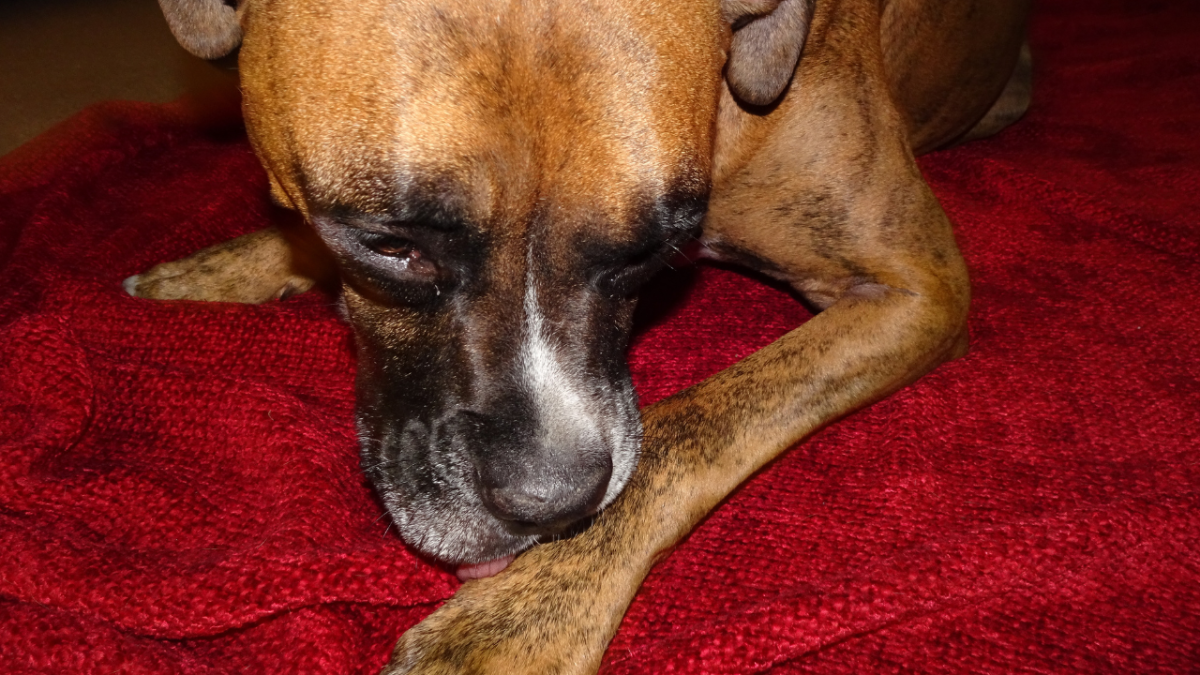Canine intestinal parasites
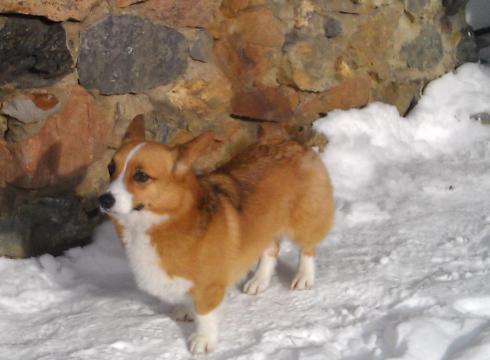
Dogs may be exposed to a number of parasites, depending on their habitat and living conditions. Dogs in rural areas often hunt and eat objects that could be sources of parasitic infection. Dogs that live in crowded conditions have a greater chance of parasitic infection through transfer to those in close proximity.
In general, clinical signs of intestinal parasites are variable and may be quite vague. Diarrhea is a common sign of intestinal parasites, but is not always present, and may be intermittent. Vomiting may be a sign of certain internal parasites. The characteristics of the stool (color, presence of absence of mucus or blood) are important clues to the type and severity of parasitic infection. Long-standing intestinal parasitism can lead to anemia, weight loss, and dehydration.
Most intestinal parasites may be diagnosed by fecal flotation. However, some parasites are better detected by examining a direct smear of the feces. There are many different parasites that can infect the intestinal tract of the dog. The most common parasites are roundworms, hookworms, whipworms, tapeworms, coccidia, and giardia. Other parasites such as amebas, spirocerca, parasitic gastritis, and salmon fluke may also occur.
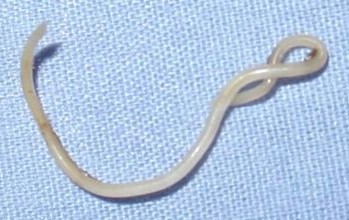
Roundworms in dogs
Roundworms (Toxocara canis, Toxascaris leonina) occur in dogs around the world. Eggs are passed in the feces of infected dogs, and undergo maturation for 5 to 15 days at temperatures between 60 to 95F to form larvae. Eggs are resistant to cold temperatures, and may survive cold winters. They are also resistant to most disinfectants. Direct sunlight is able to destroy eggs.
Dogs are infected through the ingestion of embryonated eggs. When the larva reach the stomach and upper intestine, they burrow into the wall of the gut. After 9 to 15 days, they return to the lumen of the intestinal tract and grow to maturity in about 45 days. Larvae may also cross through the placenta of pregnant bitches, infecting the fetuses. In the fetus, the larva migrate through the liver and lungs. After birth, larvae migrate in the lungs, are coughed up and swallowed, where they can infect the intestinal tract. Even if a bitch is determined to be free of roundworms by fecal examination, larvae may remain trapped in certain tissues, and these larvae can be released during pregnancy, infecting the puppies. It is also possible that roundworm larvae may be transmitted through milk to newborn puppies.
Mice, cockroaches, and earthworms may harbor roundworm larvae. Dogs can become infected with roundworms after ingesting these hosts.
Most roundworm infections occur in young dogs. Prenatal infection is the most common. Young puppies with severe roundworm infection may develop pneumonia and bronchitis, and die before a month of age. Most puppies affected with roundworms appear unthrifty and pot-bellied, with dry, lusterless haircoats. They are usually restless, anemic, and fail to gain weight. Since roundworms can invade the stomach, vomiting may occur. Adult roundworms are sometimes present in the vomit.
Since prenatal infection is so common, puppies should be examined for roundworms. In severe infections, puppies may be wormed as early as 2 to 3 weeks of life. Many different wormers will kill roundworms. The enforcement of strict sanitation is very important since eggs can remain alive for many months. Control of rodents in kennels is important since they may serve as carriers of roundworms.
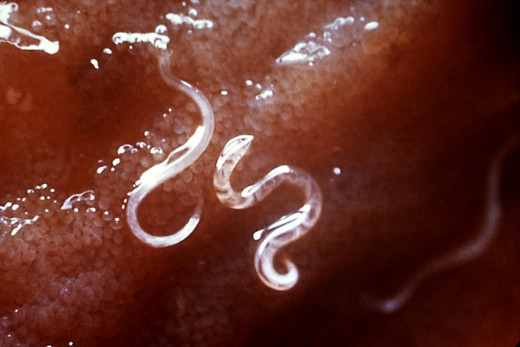
Hookworms in dogs
Hookworm infection is caused by Ancylostoma caninum, Ancylostoma brasiliense, or Uncinaria stenocephala. They are normally located in the small intestine, but may occur in the cecum or colon. Hookworms have a hook in their mouth, which bites into the intestinal wall and sucks tissue.
Eggs are passed in the feces of infected dogs. These embryonate and develop into larvae. Low temperatures delay hatching, and high temperatures or dry conditions destroy the eggs. Larvae become infective after 6 to 9 days. Sandy moist soils in tropical or semitropical climates are the most favorable conditions for hookworms.
Once infective, larvae may either penetrate the skin of the dog, or be ingested. After penetration of the skin, larvae migrate through the heart and lungs. Larvae may pass across the placenta and infect fetuses, and many may pass through the milk to newborn puppies. Hookworm eggs can be found within 10 days of birth in puppies infected prenatally and neonatally.
Larvae that penetrate the skin cause an inflammation of the skin, usually of the feet. Since hookworms attach to the wall of the intestine, blood in the stool may be seen. Stools will appear dark red or tarry, and may be fluid in consistency. Hookworms secrete an anticoagulant, and many dogs with hookworm infection will become anemic. Secondary bacterial infections of the intestinal tract are common, decreasing absorption in the intestines.
Treatment is aimed at eliminating the hookworms, and replacing blood loss, if anemic. Dogs with chronic hookworm infection should be placed on a high protein, highly digestible diet, because of the secondary bacterial infections and decreased absorption. Treatment should be repeated in 10 to 14 days to remove adults that were migrating at the time of first treatment.
Control in the environment is very important. Feces should be removed daily, before eggs can hatch. Daily cleaning with bleach in concrete-floored kennels will control infection. On gravel or dirt, spreading 10 lb sodium borate evenly over 100 square feet will kill most of the larvae. However, this will also kill most vegetation.
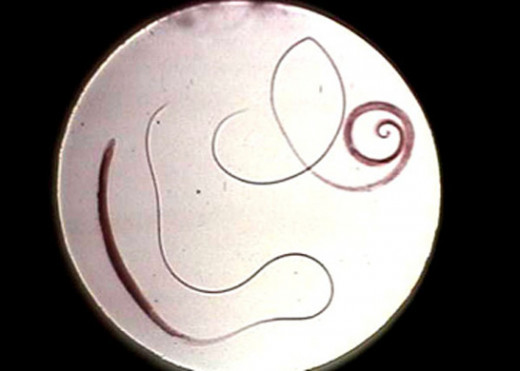
Whipworms in dogs
Whipworms (Trichuris vulpis) occur in the cecum and colon of the dog. Eggs are passed in the feces, and need to embryonate in the soil under favorable temperature and humidity conditions for 2 to 4 weeks before forming infective larvae. Once infective, larvae can live for several years in the soil, which means that elimination from the environment can be very difficult. After ingestion, larvae attach to the mucosa of the colon and cecum and grow to maturity in about 90 days.
Since it takes a long time to develop mature whipworms, whipworm infection is rarely observed in puppies younger than 3 months of age. Mild infections may produce no clinical signs. Severe infections result in a foul-smelling diarrhea that may contain specks of blood. Whipworms may be controlled by strict sanitation. Exposure to sunlight, and complete dryness for several months are lethal to whipworm eggs.
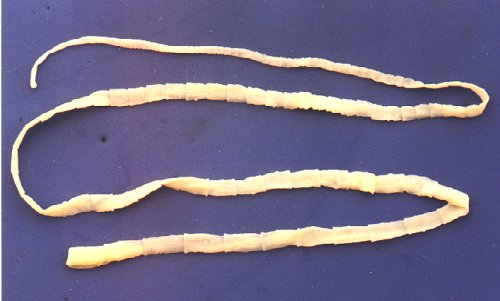
Tapeworms in dogs
The most common tapeworms of dogs are Taenia and Dipylidium. Tapeworms live in the intestinal tract, and segments break free and are passed with the feces. Eggs are passed in these segments. These eggs are then ingested by an intermediate host, where infective larvae develop. The dog becomes infected with tapeworms when it ingests tissues from the intermediate host. Infection with Dipylidium comes from the ingestion of fleas. Infection with Taenia is the result of ingesting tissues or feces from rodents, rabbits, squirrels, rats, sheep, goats, pigs, or cattle.
Infection with tapeworms may cause mucus to be passed with the stool. Other symptoms are usually vague. A poor haircoat may be the only sign of tapeworm infection. A decreased appetite may be another sign. The passing of segments through the anus causes irritation, and affected dogs will often scoot on its hind end. Diagnosis is usually made by observing the tapeworm segments in the stool. These segments usually look like small grains of rice on the surface of the stool.
Dogs can be effectively treated for tapeworms, but as soon as there is re-exposure to fleas or rodents, tapeworms will return. Control is only possible by eliminating exposure to the intermediate host such as fleas or rodents.
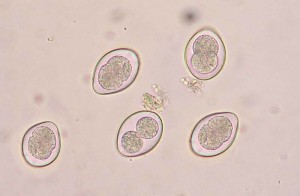
Coccidia in dogs
The presence of coccidia in the feces of dogs is fairly common. Up to 72% of dogs may have some level of infection with coccidia. Coccidiosis is typically a disease of dogs living in crowded unsanitary conditions. Puppies up to 4 months of age are most likely to show signs of infection. After ingestion of oocysts, the incubation period is usually 6 to 10 days. Diarrhea is the most common sign. Blood, mucus, and shreds of intestinal epithelium will be found in watery stool. Because of the severe diarrhea, affected dogs become dehydrated, weak, depressed, and have a decreased appetite. Secondary bacterial infections are common. Treatment may be prolonged. Control measures include good sanitation, and separation of young puppies from older dogs that may be asymptomatic carriers.
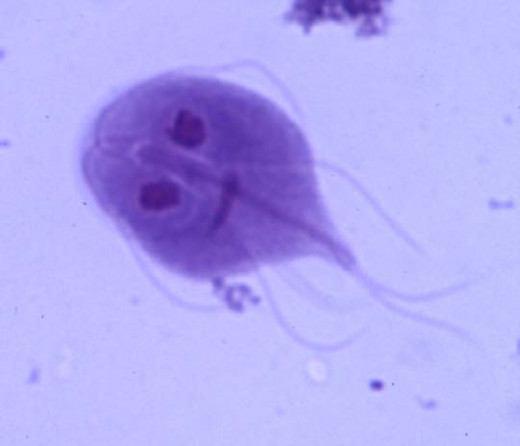
Giardia in dogs
Giardia (Giardia canis) may be found in up to 14% of all dogs, depending on geographical location. Giardia inhabits the upper part of the small intestine, and stimulates the secretion of mucus and increased motility of the small intestine. The stool becomes more liquid than normal, and contains a considerable amount of mucus. High carbohydrate diets appear to be more favorable for the development of clinical giardia infection than do high protein diets. Secondary bacterial infections may accompany giardia infections.
Controlling internal parasites in dogs
As you can see, the key to controlling most intestinal parasites is sanitation. Typically, it is more difficult to control intestinal parasites in dogs that are kept on dirt, sand, or gravel. Gravel can be particularly difficult, since it is hard to clean up all fecal material from the bits of gravel. Gravel is also more difficult to clean, due to it's uneven surface. Concrete is probably the best solid flooring material, since eggs and larvae cannot penetrate it. However, concrete must be kept clean, and feces cannot be left for days at a time. Wood is a difficult material to clean, and eggs, larvae and many bacteria can penetrate its surface. Wire flooring allows urine and fecal matter to drop through, reducing the exposure to parasites. Unfortunately, wire can be very difficult to clean if a dog does get diarrhea, and it can be hard on the feet.
Control of parasites is easier when dogs are housed individually. Individual housing reduces crowding and exposure of a non-parasitized dog to the feces of one that is infected. Dogs that are housed in a tight kennel situation tend to have more problems with parasites than do dogs that have large pasture areas to run in. Putting many dogs in a small area concentrates the number of parasite eggs shed in feces, and increases the risk for exposure. When dogs have a large pasture area to run in, feces tend to be more spread out, decreasing the risk for direct exposure. However, the feces from other farm animals such as sheep, goats, cows or pigs, that may be sharing the same space, can carry certain parasites that are infective to dogs. Certain parasites can also be carried in pond water, so exposure increases the chance of infection.
When there are many dogs in the kennel, or the chance of exposure to parasites is high, it may be a good practice to have a standard worming program in the kennel. Typically, dogs are wormed every three to four months for roundworms, hookworms, and possibly whipworms and tapeworms, depending on the wormer used. Remember that the usual wormers do not treat coccidia or giardia, and that regular wormer usage does not prevent these parasites from occurring.





